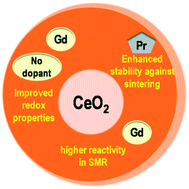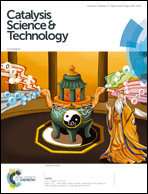Influence of Gd and Pr doping on the properties of ceria: texture, structure, redox behaviour and reactivity in CH4/H2O reactions in the presence of H2S
Abstract
Ceria materials doped by Gd and/or Pr were prepared by a precipitation route and calcined in air at 500 and 900 °C. The effects of doping and thermal treatment on the materials' surfaces were studied by X-ray photoelectron and Raman spectroscopies. The redox properties were investigated using temperature-programmed reduction experiments in H2 and CH4 followed by temperature-programmed oxidation in O2. The catalytic properties of these materials in CH4/H2O reaction in the absence/presence of H2S were evaluated at 750 °C in a large excess of CH4 with respect to H2O. The materials were classified by order of reactivity as follows: CPO > CGPO > CeO2 > CGO, which can be primarily related to the surface area variation. Comparing the activity per m2 of various samples indicates that the catalytic activity is correlated with the Ce3+ concentration at the surface as measured by XPS. Gd-doped and undoped samples exhibit the highest surface Ce3+ concentration as well as the highest activity in SMR per m2, while Pr-doped samples are the least active (activity per m2) with the lowest surface Ce3+ concentrations. H2S has a sharp promoting effect on the catalytic behavior of ceria-based materials, improving the production of H2 by almost one order of magnitude.



 Please wait while we load your content...
Please wait while we load your content...